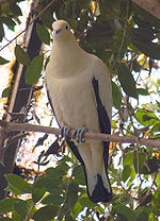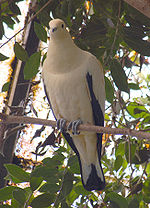
Pied Imperial-Pigeon
Encyclopedia
The Pied Imperial Pigeon (Ducula bicolor) is a relatively large, pied species of pigeon. It is found in forest, woodland, mangrove, plantations and scrub in Southeast Asia
, ranging from Myanmar
and Thailand
south to Java
and east to the Philippines
and the Bird's Head Peninsula
in New Guinea
. It is mainly found on small islands and in coastal regions. It remains locally common, and is therefore considered to be of least concern
by BirdLife International
and IUCN.
 Its taxonomy
Its taxonomy
is confusing and remains unsettled. It has sometimes included the Torresian, Yellowish and Silver-tipped Imperial Pigeons as subspecies
. The widespread nominate subspecies of the Pied Imperial Pigeon differs from all these by its plain white thighs and undertail coverts
(though often with a dark spot at the very tip), and its narrowly dark-tipped bluish bill. For comparison, the other species' have black-spotted undertail coverts and thighs (spotting mainly near thighs in Silver-tipped Imperial Pigeon), the bill of the Torresian Imperial Pigeon is greenish-yellow, and the bills of the Yellowish and Silver-tipped Imperial Pigeons are bluish at the base and yellowish at the tip. Furthermore, the Yellowish Imperial Pigeon has a distinctive yellowish tinge to its plumage
(some Pied Imperial Pigeons may also appear yellowish, but infrequently to the same extend), and the Silver-tipped Imperial Pigeon has silvery-grey remiges. However, the taxon
melanura of the Moluccas, which usually is considered a subspecies of the Pied Imperial Pigeon, resembles the Torresian Imperial Pigeon in bill, thighs and undertail coverts, but has a significantly broader black tail-tip. Consequently, some have suggested it should be placed under the Torresian Imperial Pigeon, while others have suggested it should be considered an entirely separate species, D. melanura (for which the name Black Imperial Pigeon has been used – an unfortunate choice, as only the tail has significantly more black than the other members of this group, and the name Black Imperial Pigeon usually has been used for D. melanochroa). Yet others have considered melanura to be invalid, instead believing it only is a morph of D. b. bicolor, as both types can be found on some islands.
Southeast Asia
Southeast Asia, South-East Asia, South East Asia or Southeastern Asia is a subregion of Asia, consisting of the countries that are geographically south of China, east of India, west of New Guinea and north of Australia. The region lies on the intersection of geological plates, with heavy seismic...
, ranging from Myanmar
Myanmar
Burma , officially the Republic of the Union of Myanmar , is a country in Southeast Asia. Burma is bordered by China on the northeast, Laos on the east, Thailand on the southeast, Bangladesh on the west, India on the northwest, the Bay of Bengal to the southwest, and the Andaman Sea on the south....
and Thailand
Thailand
Thailand , officially the Kingdom of Thailand , formerly known as Siam , is a country located at the centre of the Indochina peninsula and Southeast Asia. It is bordered to the north by Burma and Laos, to the east by Laos and Cambodia, to the south by the Gulf of Thailand and Malaysia, and to the...
south to Java
Java
Java is an island of Indonesia. With a population of 135 million , it is the world's most populous island, and one of the most densely populated regions in the world. It is home to 60% of Indonesia's population. The Indonesian capital city, Jakarta, is in west Java...
and east to the Philippines
Philippines
The Philippines , officially known as the Republic of the Philippines , is a country in Southeast Asia in the western Pacific Ocean. To its north across the Luzon Strait lies Taiwan. West across the South China Sea sits Vietnam...
and the Bird's Head Peninsula
Bird's Head Peninsula
The Bird's Head Peninsula or Doberai Peninsula is a large peninsula that makes up the northwest portion of the Province of West Papua, Indonesia.-Location and geography:...
in New Guinea
New Guinea
New Guinea is the world's second largest island, after Greenland, covering a land area of 786,000 km2. Located in the southwest Pacific Ocean, it lies geographically to the east of the Malay Archipelago, with which it is sometimes included as part of a greater Indo-Australian Archipelago...
. It is mainly found on small islands and in coastal regions. It remains locally common, and is therefore considered to be of least concern
Least Concern
Least Concern is an IUCN category assigned to extant taxon or lower taxa which have been evaluated but do not qualify for any other category. As such they do not qualify as threatened, Near Threatened, or Conservation Dependent...
by BirdLife International
BirdLife International
BirdLife International is a global Partnership of conservation organisations that strives to conserve birds, their habitats and global biodiversity, working with people towards sustainability in the use of natural resources...
and IUCN.
Taxonomy

Taxonomy
Taxonomy is the science of identifying and naming species, and arranging them into a classification. The field of taxonomy, sometimes referred to as "biological taxonomy", revolves around the description and use of taxonomic units, known as taxa...
is confusing and remains unsettled. It has sometimes included the Torresian, Yellowish and Silver-tipped Imperial Pigeons as subspecies
Subspecies
Subspecies in biological classification, is either a taxonomic rank subordinate to species, ora taxonomic unit in that rank . A subspecies cannot be recognized in isolation: a species will either be recognized as having no subspecies at all or two or more, never just one...
. The widespread nominate subspecies of the Pied Imperial Pigeon differs from all these by its plain white thighs and undertail coverts
Covert (feather)
A covert feather on a bird is one of a set of feathers, called coverts, which as the name implies, cover other feathers. The coverts help to smooth airflow over the wings and tail.- Wing-coverts :...
(though often with a dark spot at the very tip), and its narrowly dark-tipped bluish bill. For comparison, the other species' have black-spotted undertail coverts and thighs (spotting mainly near thighs in Silver-tipped Imperial Pigeon), the bill of the Torresian Imperial Pigeon is greenish-yellow, and the bills of the Yellowish and Silver-tipped Imperial Pigeons are bluish at the base and yellowish at the tip. Furthermore, the Yellowish Imperial Pigeon has a distinctive yellowish tinge to its plumage
Plumage
Plumage refers both to the layer of feathers that cover a bird and the pattern, colour, and arrangement of those feathers. The pattern and colours of plumage vary between species and subspecies and can also vary between different age classes, sexes, and season. Within species there can also be a...
(some Pied Imperial Pigeons may also appear yellowish, but infrequently to the same extend), and the Silver-tipped Imperial Pigeon has silvery-grey remiges. However, the taxon
Taxon
|thumb|270px|[[African elephants]] form a widely-accepted taxon, the [[genus]] LoxodontaA taxon is a group of organisms, which a taxonomist adjudges to be a unit. Usually a taxon is given a name and a rank, although neither is a requirement...
melanura of the Moluccas, which usually is considered a subspecies of the Pied Imperial Pigeon, resembles the Torresian Imperial Pigeon in bill, thighs and undertail coverts, but has a significantly broader black tail-tip. Consequently, some have suggested it should be placed under the Torresian Imperial Pigeon, while others have suggested it should be considered an entirely separate species, D. melanura (for which the name Black Imperial Pigeon has been used – an unfortunate choice, as only the tail has significantly more black than the other members of this group, and the name Black Imperial Pigeon usually has been used for D. melanochroa). Yet others have considered melanura to be invalid, instead believing it only is a morph of D. b. bicolor, as both types can be found on some islands.

